|
|
||||
| home > architetture | ||||
| CHORA,
GROSS MAX, J. GROOTENS. The Landing |
||||
| The
Landing is the project by Chora, GroosMax e Joost Grootens, winner in
the invited competition for a new public park in Arnhem, The Netherlands.
ARCH'IT presents its theme and strategies through the words of Raoul
Bunschoten of Chora: Touching
the Second Skin offers an occasion for better understanding the
research of the Dutch/English group, whose last exhibition, 'From Matter
to Metaspace', just opened at The Institute for Cultural Policy in Hamburg. |
||||
| [in italiano] | The
creation of brand new public spaces too often rely on formal solutions
that fail to make strong connection with the local context represented
by the differing needs of its individuals. Regardless of their aesthetic
merits, such designs alters the shallowest elements of a city only without
touching the deeper social, historical, and cultural dynamics that constitute
an urban experience and that precede the emergence of any architectural
form. These problems become even more evident when one is confronted
with the design of a public space in a city that does not even exist
yet. In fact, the site of the competition, which the team made up by
Chora, GroosMax and J. Grootens was invited to, is part of the latest
and largest of the VINEX developments; a 120,000 people city will cluster
around this very core situated on the outskirt of Arnhem, The Netherlands. |
[06nov2005] | ||
 Archaeology of the earth. Archaeology of the sky. Still, any territory is never really a blank space. Notions of borders, civilizations, and conflicts are layered on top of each other to create a dynamics that ultimately becomes embedded in culture. This site is no exception. Prehistoric civilizations, the Romans, Medieval settlements, and, more recently, battles fought during the Second War World have come to constitute the culture of this area. Faced with these issues, some questions start to emerge: how can any move be still meaningful in such context? How is it possible to generate a public space from scratch? How can a public space commemorate without running the danger of falling into complacency or simple nostalgia? |
||||
 An image from the book A Bridge too far. In order to supersede this sterile process we need to engage the local context as directly as possible. However, this cannot be achieved without a methodological approach that seeks opportunities and then takes advantage of them. This two-folded problem is for us a matter of freedom and control. On the one hand, freedom allows us to engage local dynamics and helps us to design the content of the project that will then become the trigger for forms. These will in turn emerge only if a set of constrains and rules is in place so that they can be transformed into plastic elements to play with. In fact, a public space is a functional element of city making but it is also an agora, a means of expression of a society that reflects in it its dreams, needs, and expectations. Freedom and control are the elements of this project. |
||||
 Study of the morphing of a parachute from jump to landing.  Project layers: ground, parachutes, railings, and pavilions. |
FREEDOM.
The freedom we are thus referring to is the one that allows us to break
free from formulaic and sterile modus operandi to be able to
embody dreams and expectations into a single design. The project must
be able to capture the forces acting on a territory to turn them into
operational tools. Here we devised two main sets of forces to confront
the design with: those shaping the site from the ground, which we call
archeology of the earth, and those from the sky, named archeology
of the sky.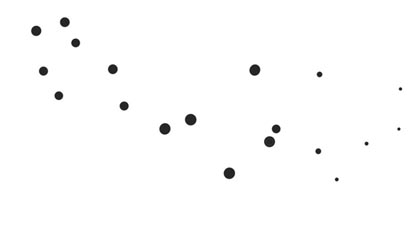 Parachutes pattern. The former is about the layers of history and archeology that are now buried underneath the site and that constitute its memory. The latter refers to the history of these skies which is much more recent. During the Second World War the surroundings of Arnhem were the stage for one of the most important battles fought. The allies planned to get to Berlin by defeating the nazi along the Dutch front, which was supposed to be weaker than the French one. The battle, which became famous through the book and movie both titled A Bridge Too Far, was lost and, as a result, the war lasted one more year. 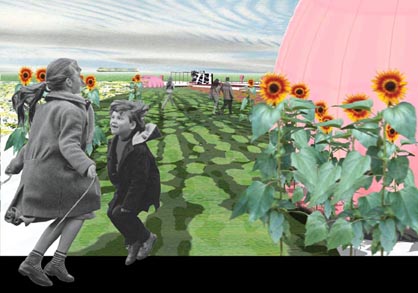 Public field. Montage. The creation of a brand new public space is about capturing these forces to ensure that they will not be forever lost. To do so, it is necessary to generate a narrative, a sequence of emotions that can be re-created daily, almost like a ritual, in order to embed the project in the dynamics of the local community and to transform an element of a mournful past into an emblem of the future. In this project this narrative has to do with time and history. The history of these skies tells the story of the parachutists that landed here in the attempt to put an end to the WWII. The unfolding of a parachute and its morphing in time is a narrative in itself; time is encapsulated in this sequence in which the parachute takes a variety of shapes each unique in its configuration. We designed this sequence and laid it on the site to re-create such narrative. The result is a choreography layout that will be constantly animated in unpredictable ways by the unique trajectory that each person will choose to experience the field. The poetic character of the initial experimentations gives way to a range of possibilities to inhabit the space that constitutes an element of freedom for its inhabitants. By doing so, the resulting space becomes be a playful one, a celebration of life that will evolve according to the changes of this community. CONTROL. Still, how can the dynamics of these poetic elements be understood as pure plastic forms that can be handled, shaped? How can these elements be scripted into the project in such way that they do not become merely formal solutions but they rather invite the public to inhabit them and give a personal interpretation to them? We feel that it becomes a matter of control, discipline and precision that has to be investigated through diagrams and systems. The tightness of this procedure is not to be understood as a rigid limitation of possible developments of the project. On the contrary, only by systematically approaching design problems can we exploit potentials to its full. |
 Plan showing the color scheme for landscape organization.  Annotated plan showing project components. |
||
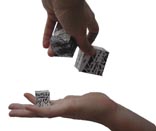 |
 Study for pavilions' skins. The methodical study of the projects' components is rather meant to act as an enabler, a device through which immaterial themes related to memory and history can be turned into tangible forms and ultimately architecture. Control is an operational device. The project transforms the poetic themes into diagrams, four of them will also orchestrate the program and future possible uses of the site. These layers are named after the objects they organize: parachutes, pavilions, railings, and ground. |
|||
Transversal Section.  Catalogue of railings' variations. |
 For instance, the nineteen parachutes scattered on the site will link the poetic theme of memory to specific programs. Some parachutes will be geometrically fairly short and large to be used as benches or actual play-scapes, while others, much taller, will stand out as almost totemic structures. Similarly, the system of railings will have several functions: it will "guide" people through the area, separate zones with different characters, and narrate the archaeological history buried there. In conclusion, we can reiterate (affirm) that the design of a public space is a problem that is much deeper and complex to be simply handled and "solved" through form only. Its dynamics and the social and cultural relevance that it has in society is such that we have to devise tools able to engage the local context and are dynamics themselves. The design of dynamic plans (or systems) allows the construction of a platform onto which landscape and community can eventually co-evolve. Then the problem is no longer "filling" or "fixing" public spaces but rather exploring the opportunities and potentials provided by the interaction between landscape and community. Raoul Bunschoten Roberto Bottazzi gc@chora.org |
 A parachute used as bench. |
||
| Project
description Winning entry in an invited competition for a new public park in the new Vinex development in Arnhem, The Netherlands. The project was awarded in March 2005. The design is orchestrated by four layers each representing elements of the landscape and acting as a systematic tool to organize the use of the space. These four layers are: ground, railings, parachutes and pavilions. |
||||
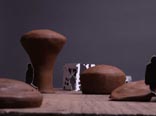 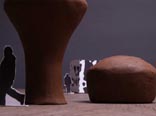 |
PARACHUTES. A series of parachutes, with the exact shape of those used
during WWII, is arranged on a pattern to perform various functions ranging
from venues for programs to more iconic, almost totemic, emblems. The
shapes of these elements will vary by following the actual morphing
of the shape of a parachute from the jump up to the landing on the ground.
The final configuration will organize the area to allow a series of
events to occur around them. Technically, the parachutes will be fabricated
by using the so-called file to factory process. Molds will be milled
by using computer numerically controlled (CNC) machines, and then glass
fiber reinforced concrete (GFRC) will be cast on the molds to obtain
the final pieces. Through this technology it is possible to combine
the mechanical qualities and strengths of a monocoque structure and
still push the thickness of the material to its limits. PAVILIONS. The entry provides four small pavilions to house programs that will generate income to run the project. They are one-storey structures that vary in size to contain: a communal room, a flower shop, a café and a news stand. RAILINGS. A system of railings will run throughout the site in order to connect different areas and narrate the archeological past of the site. They will frame areas of the site, display archeological fragments by having them enchased on the railings and illustrate the history of the site. GROUND. The ground surface is organized by series of lines oriented along the flow of the Rhine. They produce a striation in the ground that is programmatically activated by the use of either hard (like stone and gravel) or soft (such as sand, loam and clay) paving surfaces. The result is landscape plan that acquires a quasi-painterly quality: a composition of colors and textures. |
|||
| CHORA,
GROSS MAX, J. GROOTENS. The Landing |
||||
| design
team: Chora Architecture and Urbanism (Raoul Bunschoten with Roberto Bottazzi, Stefania Boccaletti, Jorge Godoy, Ophir Nafshi) GroosMax (landscape architects) Joost Grootens (graphic and product designer and design consultant) |
||||
| Chora
/ Raoul Bunschoten. Raoul Bunschoten studied architecture in
the Netherlands, Switzerland and the United States. While teaching at
the Berlage Institute and the Architectural Association in London from
1983 to 2001, he founded Chora, in 1994. Originating from a research
laboratory, Chora is a place where forward-looking thinking and practical
action are combined. Chora is developing the concept of dynamic planning
and has a tool kit, called the "Urban Gallery", to orchestrate
this. It is organized around four principal factors: a database, prototypes,
scenario games, and action plans. The workshops organized in urban centres
like Copenhagen are conceived as scenario games, based on dialogue between
participants. These dialogues are intended to give rise to prototypes,
and new urban concepts revealing the requirements and a better understanding
of the site potential. Chora-Architecture and Urbanism has formulated
concrete urban prototypes: study of the outskirts of Linz, in Austria,
1994-1995; urban renovation of East Manchester, 2000; Aarhus Horizon
in Copenhagen, 2000. It stresses the need to understand these complex
dynamic situations, and construct active maps from them, as well as
operational models, and prototypes (Liminal Bodies). Raoul Bunschoten
and Chora are, in particular, the authors of Public Spaces-Prototypes,
(2002), A Passage through Silence and Light: Daniel Libeskind's
Extension to the Berlin Museum (2002), and Metaspaces
(2000) and Urban Flotsam (2001). Parallel to this activity,
since 1994, Chora has also produced several of architectural projects
be it in the area of research, private and public commissions, or national
and international competitions. Amongst this vast production some works
stand out: Aarhus Harbour Areas, Aarhus, Denmark (3rd Prize) 1999; Hoje
Taastrup, new suburb city (2nd Prize) 2001; Colgan Hall (commissioned
multifunctional public building), Republic of Ireland 2002; The Landing,
Arnhem, The Netherlands (1st prize) 2005. Many of these designs investigate
some crucial architectural issues which have become central in Chora's
work such as: notion of public space, materiality, adaptation and proliferation. Roberto Bottazzi studied and worked both in Italy and Canada before joining CHORA in London in 2004. Ever since, he has been developing a number of architectural projects and researches on materials and fabrication techniques. He assists Raoul Bunschoten at London Metropolitan University and was project leader in the "The Landing" competition in 2005. |
||||
|
>
FILES: RAOUL BUNSCHOTEN: TOUCHING THE SECOND SKIN > CHORA |
||||
| Per
candidare progetti laboratorio
|
|||||